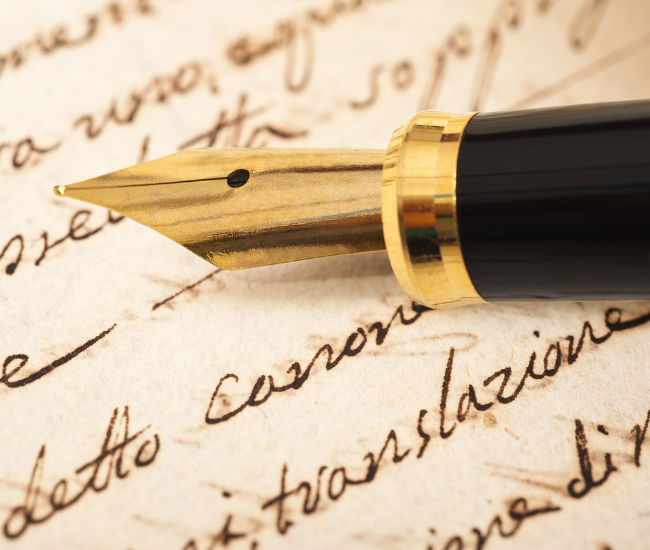If you’re looking to learn how to write letters and emails in French, you’ll need to learn a few key components: a proper salutation, a polite introduction, and a formal closing sentence. Everything else in your letter will depend on the reason you’re writing it.

Guide to writing letters and emails in French
And if you’re wondering if the French are really writing letters anymore. They are! Even though you might be looking to learn cool slang words or how to order a delicious French meal as a new French learner, you’ll be surprised by how much learning how to write letters and emails in French will come in handy–especially if you plan to live here.
Why to Learn How to Write Letters and Emails in French
For a quick example, I’m currently in the process of applying for a new visa here in France. When I was applying from the United States for past visas, the visa department had a phone helpline, an email address, and an easy online messaging system for questions and concerns.
But here in France, things are a little bit more complicated. When I was applying last month, there was no phone number (or even email!) so I had to physically go into the office to ask a question and apply for my visa. When I got to the prefecture they told me I couldn’t turn in my application there, but I instead had to mail it to them.
I didn’t understand why I had to physically mail them my application when I could’ve quite literally reached my hand across the table and given it right to them at my appointment. But, I digress.
But it’s not just the French government that loves letters. When canceling a French phone line, you have to mail a letter to the phone carrier. When you want to move out of your apartment, you have to mail a letter to your landlord. And when you close a bank account, you have to send your bank a letter in order to do so.
In the United States, all of these things could be done with either a quick trip to the physical location or just with a phone call. Here in France, it’s letters only. Hopefully, now you’re convinced of the importance of learning letter (and occasionally email) writing in France so let’s dive into exactly how to do it.

Writing a French Letterhead
If you’ve ever written a formal letter, it’s likely you’ve included a letterhead (un en-tête in French) in the top left corner. A letterhead usually includes important details like where and when the letter was written.
In French, there are a few different formatting options, but usually, you’ll write your name and address on the top left and then the name of your recipient underneath it on the right like this:
Your name
Your address
Your phone number/email
Recipient’s name
Recipient’s address
For an email, you don’t have to worry about this since the time and destination are known automatically.
Learning How to write letters and emails in French: A Proper Salutation
As you know, when writing any letter or email, it’s important to start off with who you’re addressing. In English, we almost exclusively say “dear” before the name of whoever we’re writing to, but in French you’ll usually only use “dear” or “very dear” for people you know.
- Cher (m.) / Chère (f.) = Dear
- Très cher (m.) / Très chère (f.) = Very dear
If you’re writing to somewhere you don’t know, you’ll usually just start off with their title like Madame (Mrs.), Monsieur (Mr.), Docteur (Dr.), etc. When I received a letter back from the French visa office saying I was missing a few papers for my application they simply addressed the letter, “Madame.”
Learning How to write letters and emails in French: A Polite Introduction
Now that you’ve chosen the right salutation, it’s time to start off with a polite introduction. You don’t want to dive into the letter without introducing the subject first, so here are a few ways to do so.
Je vous contacte pour = I’m contacting you to…
Le but de cette lettre est de = The goal of this letter is to…
Je vous informe par la présente que = I hereby let you know..
If you’re sending you letter after a specific event you can also start your letter with some context like this:
Suite à notre conversation téléphonique du = After our phone conversation…
À la suite de notre dernière rencontre… = After our last meeting…
Je vous remercie de votre courrier du… = Thank you for your letter…

Learning How to Write Letters and Emails in French: A Formal Conclusion
Once you’ve added your en-tête, written your polite introduction, and explained why you’re writing your letter or email, it’s time to start writing. The content of this part of the letter/email will be totally dependent on your subject and there aren’t any specific rules to be aware of (besides using formal language if you’re writing to someone you don’t know).
But, there are a few rules when it comes to the conclusion. The difficult thing about choosing a concluding sentence is that depending on where you fall in the hierarchy of the relationship and the customs of the organization/business, the conclusion might differ.
If I’m responding to a letter or email, I’ll usually just use the same conclusion they use since that’s usually the safest choice. But here I’ll list a few formal conclusions, which will always be the last sentence of your letter, from most formal to least formal.
Very Formal:
Veuillez recevoir, Monsieur, l’assurance de ma considération distinguée.
Please accept, Sir, the assurance of my distinguished consideration.
Je vous prie de croire, Madame, en l’assurance de mes sentiments les meilleurs.
Please believe, Madame, the guarantee of my best intentions.
Veuillez recevoir, Madame/Monsieur, l’expression de mes sentiments distingués.
Please accept, Madame/Sir, the exprespression of my distinguished intentions.
Formal:
Veuillez agréer, Monsieur, l’assurance de mes sentiments respectueux.
Please accept, Sir, the assurance of my respectful intentions.
Croyez, chère Madame, à mes sentiments les meilleurs.
Believe, dear madam, my best intentions.
Least Formal:
Amicalement.
Bien amicalement.
Amitiés.
Bien à vous.
Sincères salutations.
Sincèrement.
Bien sincèrement.
Cordialement.
Bien cordialement.
These can all be used to replace “Yours,” “Best wishes,” “Kind regards,” “Regards,” and “Best,”.
Now that your letter is complete you can sign your name. For really formal emails and letters, especially those used for administrative purposes, you can add the date and the place you wrote the letter/email underneath your name like this:
Je vous prie de croire, Madame, en l’assurance de mes sentiments les meilleurs.
[Signature]
[NAME]
Fait le [date] à [location]
And that’s it! You’ve learned all of the basics of writing a French letter. Happy writing!
Become an expert in French letter writing!
Our good friend, Camille, at Frenchtoday.com and the creator of the À Moi Paris audio course, does also excellent job teaching how to write letters in French. This post on her site offers is a wonderful compliment to this page!
